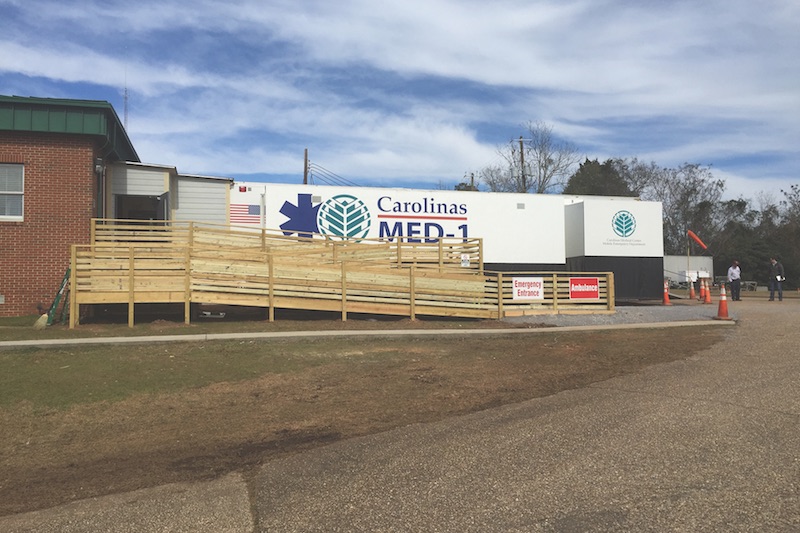Grove Hill (Ala.) Memorial Hospital is adding a new $3.75 million, 4,500-sf emergency department that will house nine exam and treatment rooms, a two-bay trauma room, expanded waiting area, and direct access to operating rooms within the hospital.
During several months of construction that started last November, Grove Hill couldn’t shut down its existing ED because it’s the only one serving Clark County. And the hospital’s administration determined that converting unutilized space into a temporary ED would be too costly.
The project’s architect, Paul Fridl of Goodwyn, Mills and Cawood, suggested an economical alternative: a mobile ED. The hospital contacted Carolina HealthCare Systems, whose Carolinas MED-1 unit for more than a decade has provided temporary patient care after natural disasters or when a hospital’s infrastructure breaks down.
MED-1 travels as two 53-foot tractor trailers. It is completely self-sustaining for the first 72 hours, using generators or local shore power.
The mobile unit comprises a 1,000-sf patient care component that is equipped and staffed to manage minor to severe emergency medical conditions; six critical-care beds with built-in cardiac monitors; full trauma surgery and anesthesia capabilities; ED acute care beds; and a dental/EENT chair. Other medical equipment—like X-ray, ultrasound, I-stat laboratory, and IV pumps—are available.
Grove Hill would prove to be MED-1’s longest stint: more than seven months. This was also the first time the mobile unit would be set up as a “permanent temporary” ED, says Brian Hale, Senior Project Manager with Robins & Morton, the GC and construction manager on the project.
Robins & Morton built a lighted, fire-sprinkler-equipped vestibule, with fire and smoke detectors, to connect the mobile unit to the existing hospital. It hooked MED-1 up to the hospital’s water supply, and replaced the ramps.
This had never been done before in Alabama, and “there were no applicable codes,” says Hale. It required creative problem-solving to overcome issues like how to wire MED-1 to the local power grid.
Read about more innovations from BD+C's 2016 Great Solutions Report
Related Stories
AEC Tech | Feb 20, 2024
AI for construction: What kind of tool can artificial intelligence become for AEC teams?
Avoiding the hype and gathering good data are half the battle toward making artificial intelligence tools useful for performing design, operational, and jobsite tasks.
Sustainability | Nov 1, 2023
Researchers create building air leakage detection system using a camera in real time
Researchers at the U.S. Department of Energy’s Oak Ridge National Laboratory have developed a system that uses a camera to detect air leakage from buildings in real time.
75 Top Building Products | Aug 7, 2023
Enter today! BD+C's 75 Top Building Products for 2023
BD+C editors are now accepting submissions for the annual 75 Top Building Products awards. The winners will be featured in the November/December 2023 issue of Building Design+Construction.
Resiliency | Aug 7, 2023
Creative ways cities are seeking to beat urban heat gain
As temperatures in many areas hit record highs this summer, cities around the world are turning to creative solutions to cope with the heat. Here are several creative ways cities are seeking to beat urban heat gain.
AEC Innovators | Jun 15, 2023
Rogers-O'Brien Construction pilots wearables to reduce heat-related injuries on jobsites
Rogers-O'Brien Construction (RO) has launched a pilot program utilizing SafeGuard, a safety-as-a-service platform for real-time health and safety risk assessment. Non-invasive wearables connected to SafeGuard continuously monitor personnel to prevent heat exhaustion on jobsites, reducing the risk of related injuries. RO is the first general contractor to pilot this program.
Office Buildings | May 15, 2023
Sixteen-story office tower will use 40% less energy than an average NYC office building
This month marks the completion of a new 16-story office tower that is being promoted as New York City’s most sustainable office structure. That boast is backed by an innovative HVAC system that features geothermal wells, dedicated outdoor air system (DOAS) units, radiant heating and cooling, and a sophisticated control system to ensure that the elements work optimally together.
Design Innovation Report | Apr 27, 2023
BD+C's 2023 Design Innovation Report
Building Design+Construction’s Design Innovation Report presents projects, spaces, and initiatives—and the AEC professionals behind them—that push the boundaries of building design. This year, we feature four novel projects and one building science innovation.
Design Innovation Report | Apr 19, 2023
Reinforced concrete walls and fins stiffen and shade the National Bank of Kuwait skyscraper
When the National Bank of Kuwait first conceived its new headquarters more than a decade ago, it wanted to make a statement about passive design with a soaring tower that could withstand the extreme heat of Kuwait City, the country’s desert capital.
Design Innovation Report | Apr 19, 2023
HDR uses artificial intelligence tools to help design a vital health clinic in India
Architects from HDR worked pro bono with iKure, a technology-centric healthcare provider, to build a healthcare clinic in rural India.
3D Printing | Apr 11, 2023
University of Michigan’s DART Laboratory unveils Shell Wall—a concrete wall that’s lightweight and freeform 3D printed
The University of Michigan’s DART Laboratory has unveiled a new product called Shell Wall—which the organization describes as the first lightweight, freeform 3D printed and structurally reinforced concrete wall. The innovative product leverages DART Laboratory’s research and development on the use of 3D-printing technology to build structures that require less concrete.

















